Pecharsky V.K., Zavalij P.Y. Fundamentals of Powder Diffraction and Structural Characterization of Materials
Подождите немного. Документ загружается.

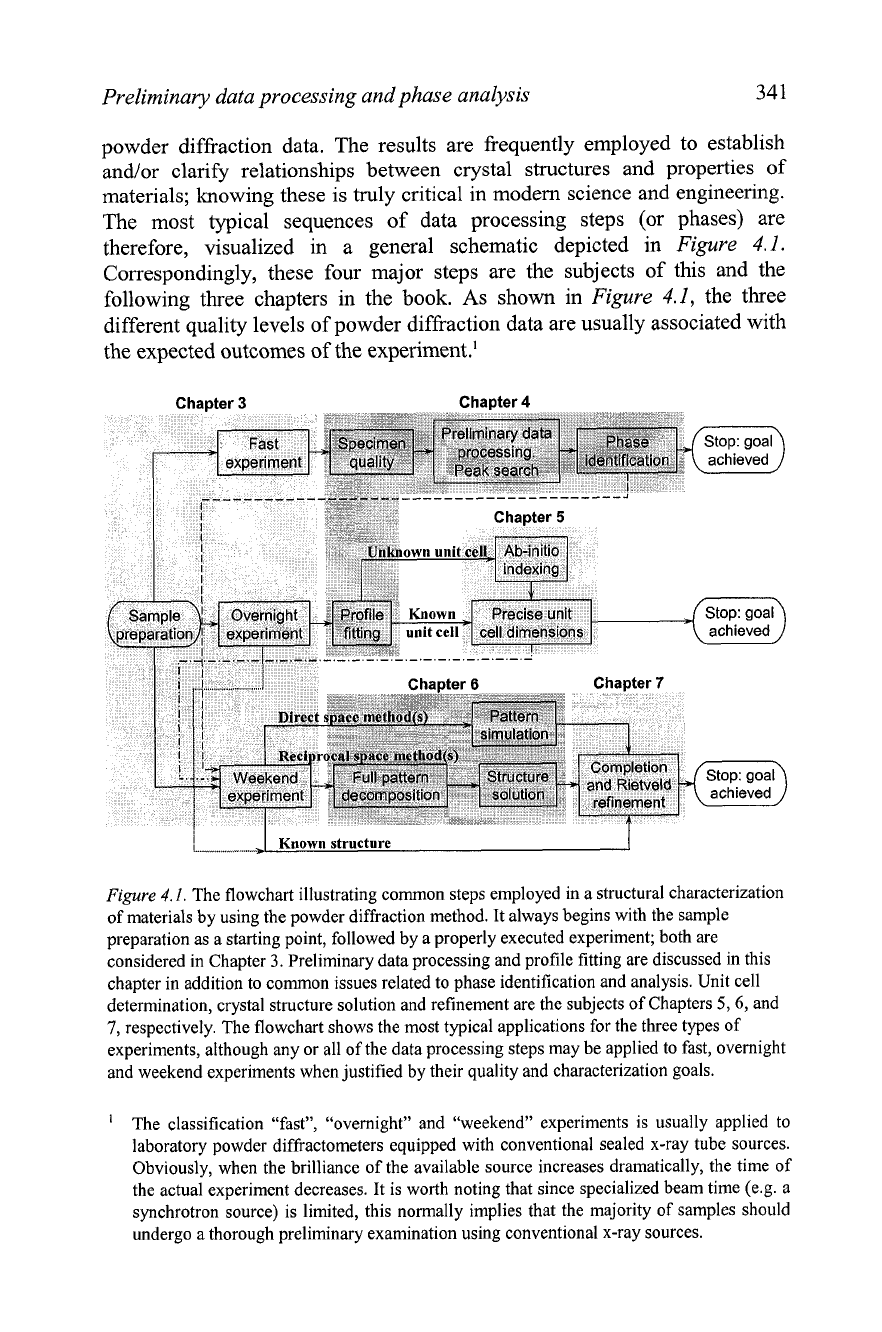
Preliminary data processing and phase analysis
34
1
powder diffraction data. The results are frequently employed to establish
andlor clarify relationships between crystal structures and properties of
materials; knowing these is truly critical in modem science and engineering.
The most typical sequences of data processing steps (or phases) are
therefore, visualized in a general schematic depicted in
Figure
4.1.
Correspondingly, these four major steps are the subjects of this and the
following three chapters in the book. As shown in
Figure
4.1,
the three
different quality levels of powder diffraction data are usually associated with
the expected outcomes of the experiment.'
i
L
Known
structure
Figure
4.1.
The flowchart illustrating common steps employed in a structural characterization
of materials by using the powder diffraction method. It always begins with the sample
preparation as a starting point, followed by a properly executed experiment; both are
considered in Chapter
3.
Preliminary data processing and profile fitting are discussed in this
chapter in addition to common issues related to phase identification and analysis. Unit cell
determination, crystal structure solution and refinement are the subjects of Chapters
5,6,
and
7,
respectively. The flowchart shows the most typical applications for the three types of
experiments, although any or all of the data processing steps may be applied to fast, overnight
and weekend experiments when justified by their quality and characterization goals.
'
The classification "fast", "overnight" and "weekend" experiments is usually applied to
laboratory powder diffractometers equipped with conventional sealed x-ray tube sources.
Obviously, when the brilliance of the available source increases dramatically, the time of
the actual experiment decreases. It is worth noting that since specialized beam time (e.g. a
synchrotron source) is limited, this normally implies that the majority of samples should
undergo a thorough preliminary examination using conventional x-ray sources.
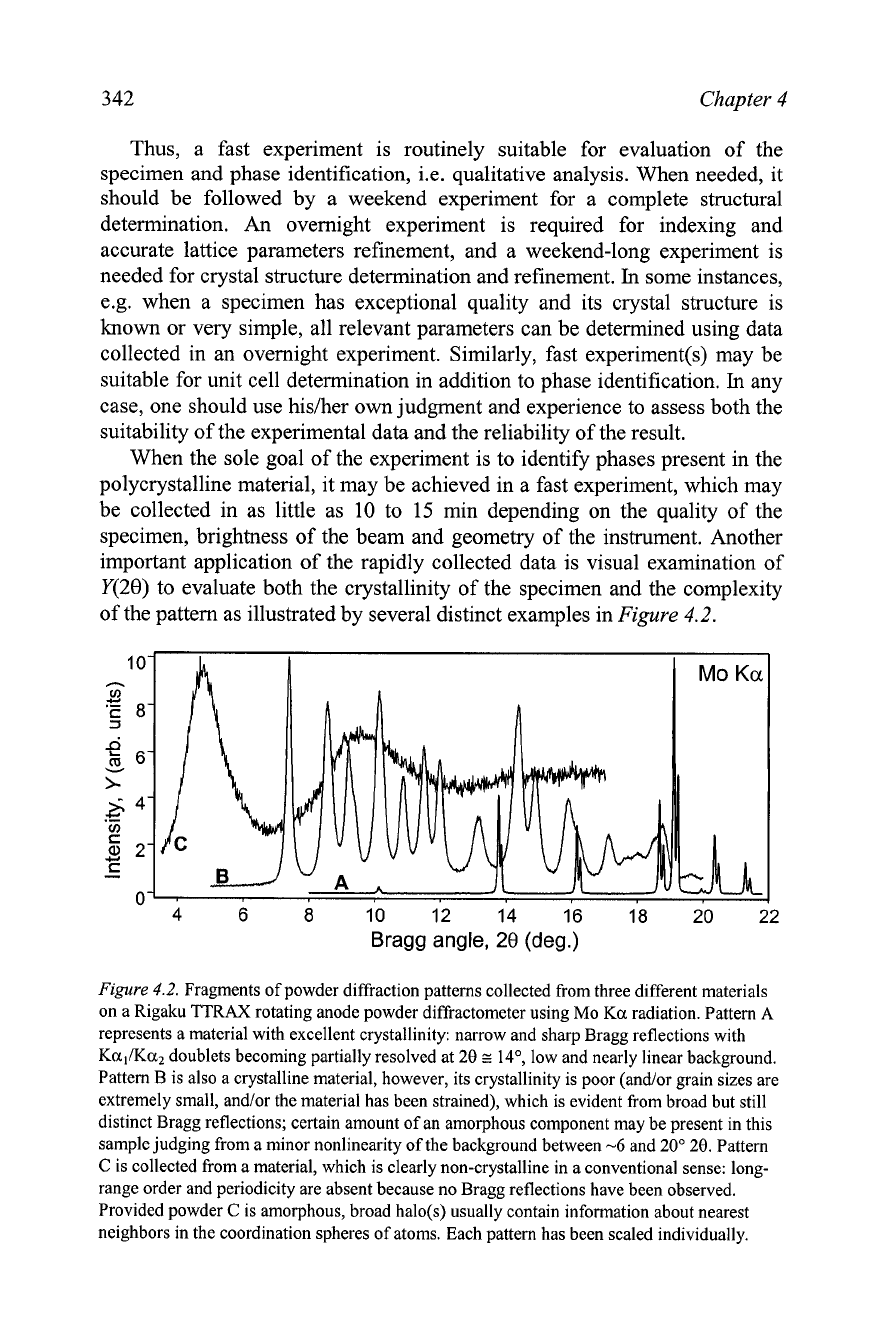
342
Chapter
4
Thus, a fast experiment is routinely suitable for evaluation of the
specimen and phase identification, i.e. qualitative analysis. When needed, it
should be followed by a weekend experiment for a complete structural
determination.
An
overnight experiment is required for indexing and
accurate lattice parameters refinement, and a weekend-long experiment is
needed for crystal structure determination and refinement.
In
some instances,
e.g. when a specimen has exceptional quality and its crystal structure is
known or very simple, all relevant parameters can be determined using data
collected in an overnight experiment. Similarly, fast experiment(s) may be
suitable for unit cell determination in addition to phase identification.
In
any
case, one should use hislher own judgment and experience to assess both the
suitability of the experimental data and the reliability of the result.
When the sole goal of the experiment is to identify phases present in the
polycrystalline material, it may be achieved in a fast experiment, which may
be collected in as little as
10
to
15
min depending on the quality of the
specimen, brightness of the beam and geometry of the instrument. Another
important application of the rapidly collected data is visual examination of
Y(28) to evaluate both the crystallinity of the specimen and the complexity
of the pattern as illustrated by several distinct examples in
Figure
4.2.
Bragg angle,
28
(deg.)
Figure
4.2.
Fragments of powder diffraction patterns collected from three different materials
on a Rigaku TTRAX rotating anode powder diffractometer using Mo
Ka
radiation. Pattern
A
represents a material with excellent crystallinity: narrow and sharp Bragg reflections with
KallKa2
doublets becoming partially resolved at
20
z
14O,
low and nearly linear background.
Pattern
B
is also a crystalline material, however, its crystallinity is poor (andlor grain sizes are
extremely small, and/or the material has been strained), which is evident from broad but still
distinct Bragg reflections; certain amount of an amorphous component may be present in this
sample judging from a minor nonlinearity of the background between
-6
and
20"
20.
Pattern
C
is collected from a material, which is clearly non-crystalline in a conventional sense: long-
range order and periodicity are absent because no Bragg reflections have been observed.
Provided powder
C
is amorphous, broad halo(s) usually contain information about nearest
neighbors in the coordination spheres of atoms. Each pattern has been scaled individually.
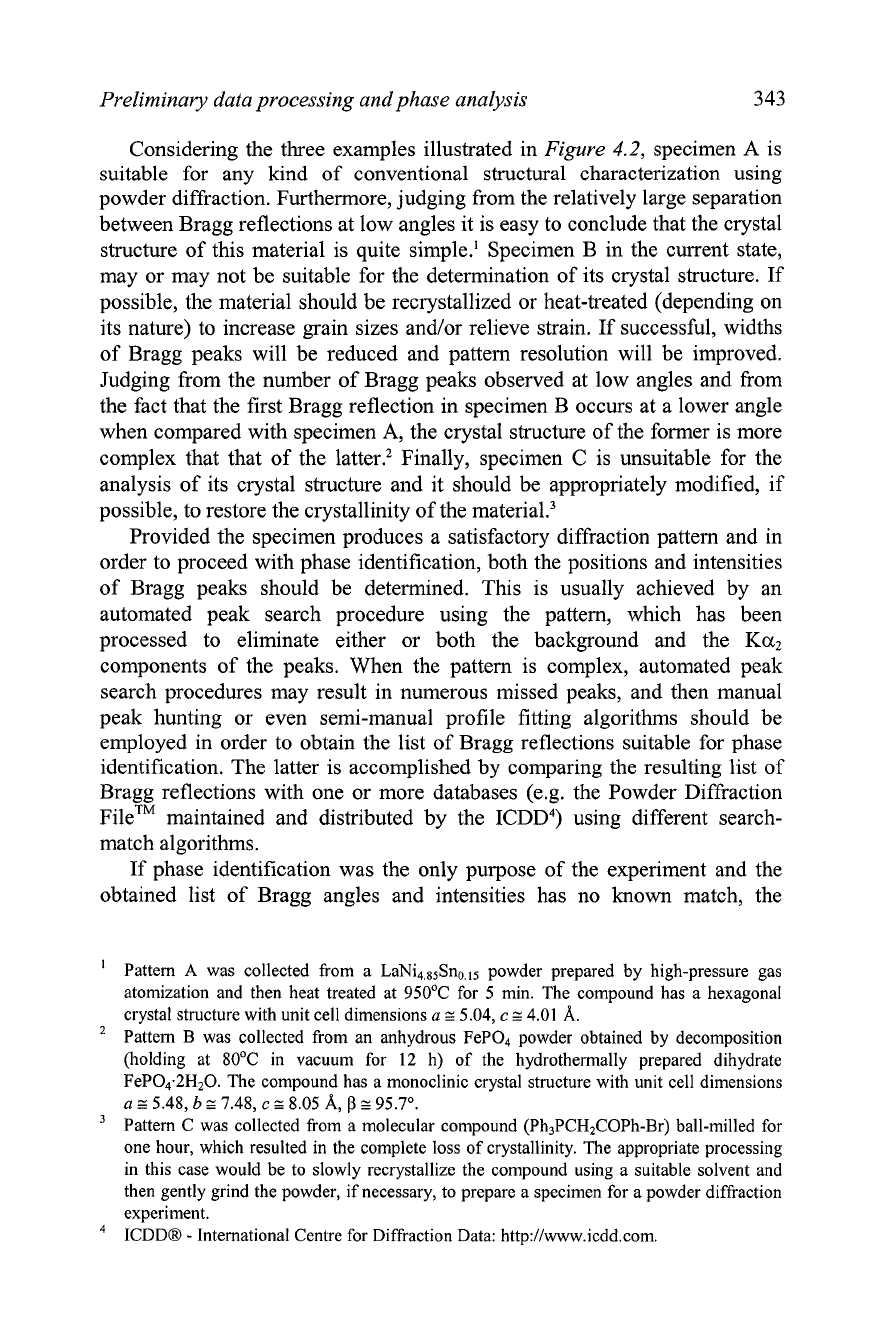
Preliminary data processing and phase analysis
343
Considering the three examples illustrated in
Figure
4.2,
specimen
A
is
suitable for any kind of conventional structural characterization using
powder diffraction. Furthermore, judging from the relatively large separation
between Bragg reflections at low angles it is easy to conclude that the crystal
structure of this material is quite simple.' Specimen B in the current state,
may or may not be suitable for the determination of its crystal structure. If
possible, the material should be recrystallized or heat-treated (depending on
its nature) to increase grain sizes
and/or relieve strain. If successful, widths
of Bragg peaks will be reduced and pattern resolution will be improved.
Judging from the number of Bragg peaks observed at low angles and from
the fact that the first Bragg reflection in specimen B occurs at a lower angle
when compared with specimen
A,
the crystal structure of the former is more
complex that that of the latter.2 Finally, specimen
C
is unsuitable for the
analysis of its crystal structure and it should be appropriately modified, if
possible, to restore the crystallinity of the
material.3
Provided the specimen produces a satisfactory diffraction pattern and in
order to proceed with phase identification, both the positions and intensities
of Bragg peaks should be determined. This is usually achieved by an
automated peak search procedure using the pattern, which has been
processed to eliminate either or both the background and the
Ka2
components of the peaks. When the pattern is complex, automated peak
search procedures may result in numerous missed peaks, and then manual
peak hunting or even semi-manual profile fitting algorithms should be
employed in order to obtain the list of Bragg reflections suitable for phase
identification. The latter is accomplished by comparing the resulting list of
Bragg reflections with one or more databases
(e.g. the Powder Diffraction
~ile~~ maintained and distributed by the ICDD4) using different search-
match algorithms.
If phase identification was the only purpose of the experiment and the
obtained list of Bragg angles and intensities has no known match, the
Pattern
A
was collected from a LaNi4,s5Sno.15 powder prepared by high-pressure gas
atomization and then heat treated at 950•‹C for 5 min. The compound has a hexagonal
crystal structure with unit cell dimensions
a
z
5.04,
c
z
4.01
A.
Pattern
B
was collected from an anhydrous FePO., powder obtained by decomposition
(holding at 80•‹C in vacuum for 12 h) of the hydrothermally prepared dihydrate
FeP04.2H20. The compound has a monoclinic crystal structure with unit cell dimensions
a
z
5.48,
b
z
7.48,
c
G
8.05
A,
P
E
95.7'.
Pattern C was collected from a molecular compound (Ph3PCH2COPh-Br) ball-milled for
one hour, which resulted in the complete loss of crystallinity. The appropriate processing
in this case would be to slowly recrystallize the compound using a suitable solvent and
then gently grind the powder, if necessary, to prepare a specimen for a powder diffraction
experiment.
ICDDB
-
International Centre for Diffraction Data: http://www.icdd.com.
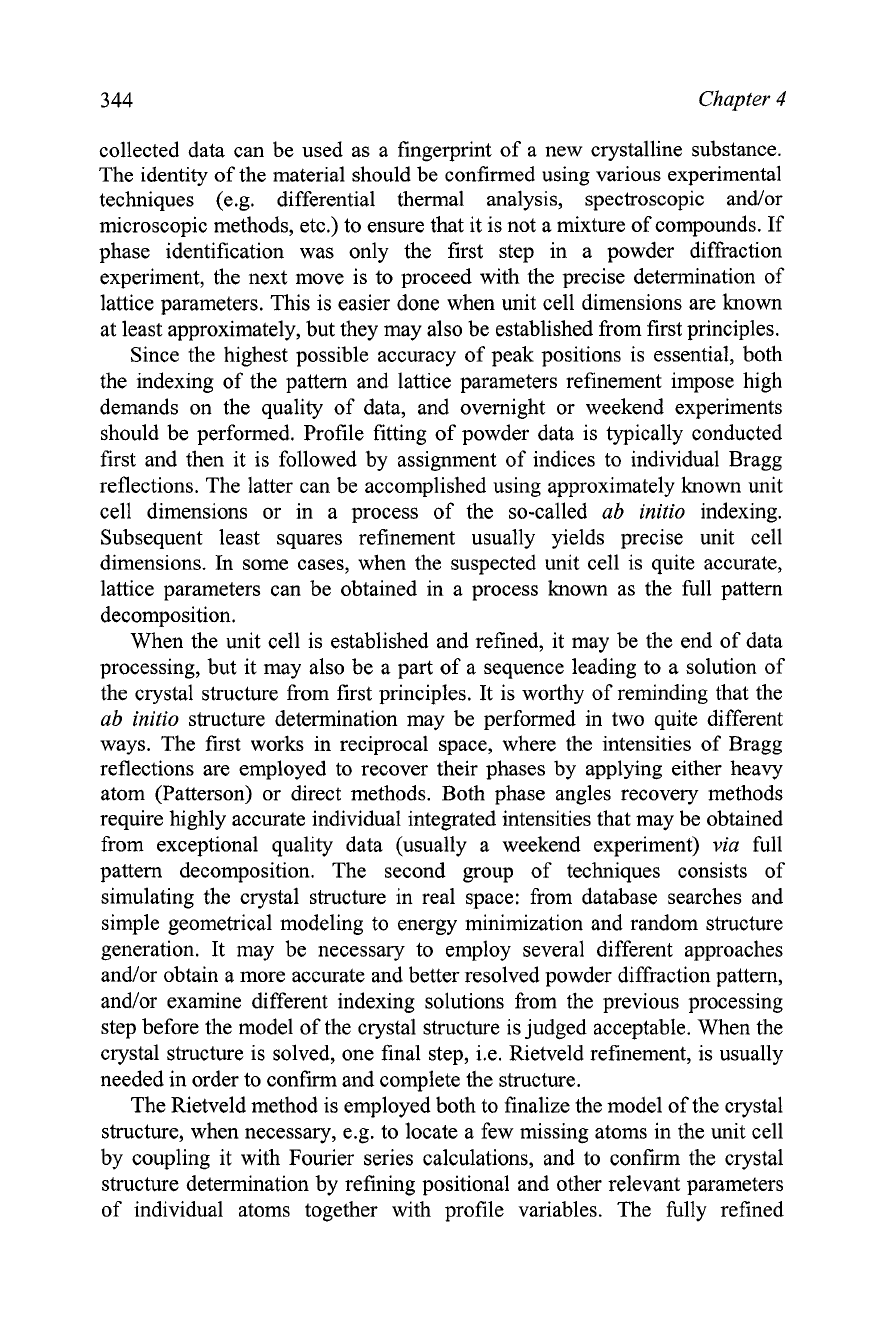
Chapter
4
collected data can be used as a fingerprint of a new crystalline substance.
The identity of the material should be confirmed using various experimental
techniques (e.g. differential thermal analysis, spectroscopic andlor
microscopic methods, etc.) to ensure that it is not a mixture of compounds. If
phase identification was only the first step in a powder diffraction
experiment, the next move is to proceed with the precise determination of
lattice parameters. This is easier done when unit cell dimensions are known
at least approximately, but they may also be established from first principles.
Since the highest possible accuracy of peak positions is essential, both
the indexing of the pattern and lattice parameters refinement impose high
demands on the quality of data, and overnight or weekend experiments
should be performed. Profile fitting of powder data is typically conducted
first and then it is followed by assignment of indices to individual Bragg
reflections. The latter can be accomplished using approximately
hown unit
cell dimensions or in a process of the so-called
ab initio
indexing.
Subsequent least squares refinement usually yields precise unit cell
dimensions.
In
some cases, when the suspected unit cell is quite accurate,
lattice parameters can be obtained in a process known as the full pattern
decomposition.
When the unit cell is established and refined, it may be the end of data
processing, but it may also be a part of a sequence leading to a solution of
the crystal structure from first principles. It is worthy of reminding that the
ab initio
structure determination may be performed in two quite different
ways. The first works in reciprocal space, where the intensities of Bragg
reflections are employed to recover their phases by applying either heavy
atom (Patterson) or direct methods. Both phase angles recovery methods
require highly accurate individual integrated intensities that may be obtained
from exceptional quality data (usually a weekend experiment)
via
full
pattern decomposition. The second group of techniques consists of
simulating the crystal structure in real space: from database searches and
simple geometrical modeling to energy minimization and random structure
generation. It may be necessary to employ several different approaches
andlor obtain a more accurate and better resolved powder diffraction pattern,
and/or examine different indexing solutions from the previous processing
step before the model of the crystal structure is judged acceptable. When the
crystal structure is solved, one final step, i.e. Rietveld refinement, is usually
needed in order to confirm and complete the structure.
The Rietveld method is employed both to finalize the model of the crystal
structure, when necessary, e.g. to locate a few missing atoms in the unit cell
by coupling it with Fourier series calculations, and to confirm the crystal
structure determination by refining positional and other relevant parameters
of individual atoms together with profile variables. The fully refined
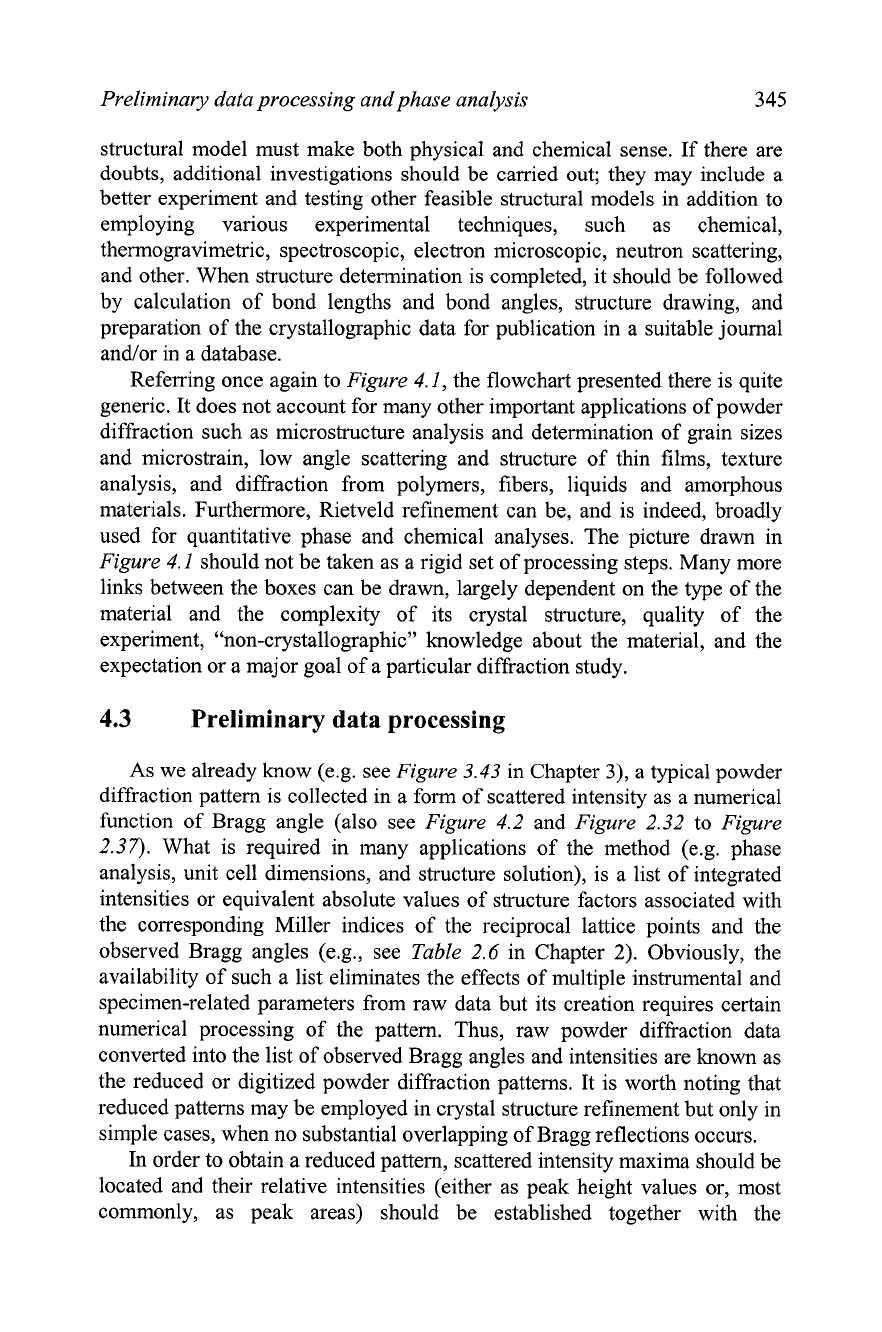
Preliminary data processing and phase analysis
345
structural model must make both physical and chemical sense. If there are
doubts, additional investigations should be carried out; they may include a
better experiment and testing other feasible structural models in addition to
employing various experimental techniques, such as chemical,
thermogravimetric, spectroscopic, electron microscopic, neutron scattering,
and other. When structure determination is completed, it should be followed
by calculation of bond lengths and bond angles, structure drawing, and
preparation of the crystallographic data for publication in a suitable journal
and/or in a database.
Referring once again to
Figure
4.1, the flowchart presented there is quite
generic. It does not account for many other important applications of powder
diffraction such as microstructure analysis and determination of grain sizes
and microstrain, low angle scattering and structure of thin films, texture
analysis, and diffraction from polymers, fibers, liquids and amorphous
materials.
Furthermore, Rietveld refinement can be, and is indeed, broadly
used for quantitative phase and chemical analyses. The picture drawn in
Figure
4.1 should not be taken as a rigid set of processing steps. Many more
links between the boxes can be drawn, largely dependent on the type of the
material and the complexity of its crystal structure, quality of the
experiment, "non-crystallographic" knowledge about the material, and the
expectation or a major goal of a particular diffraction study.
4.3
Preliminary
data
processing
As we already know (e.g. see
Figure
3.43
in Chapter
3),
a typical powder
diffraction pattern is collected in a form of scattered intensity as a numerical
function of Bragg angle (also see
Figure
4.2
and
Figure
2.32
to
Figure
2.37).
What is required in many applications of the method (e.g. phase
analysis, unit cell dimensions, and structure solution), is a list of integrated
intensities or equivalent absolute values of structure factors associated with
the corresponding Miller indices of the reciprocal lattice points and the
observed Bragg angles
(e.g., see
Table
2.6
in Chapter
2).
Obviously, the
availability of such a list eliminates the effects of multiple instrumental and
specimen-related parameters from raw data but its creation requires certain
numerical processing of the pattern. Thus, raw powder diffraction data
converted into the list of observed Bragg angles and intensities are known as
the reduced or digitized powder diffraction patterns. It is worth noting that
reduced patterns may be employed in crystal structure refinement but only in
simple cases, when no substantial overlapping of Bragg reflections occurs.
In
order to obtain a reduced pattern, scattered intensity maxima should be
located and their relative intensities (either as peak height values or, most
commonly, as peak areas) should be established together with the
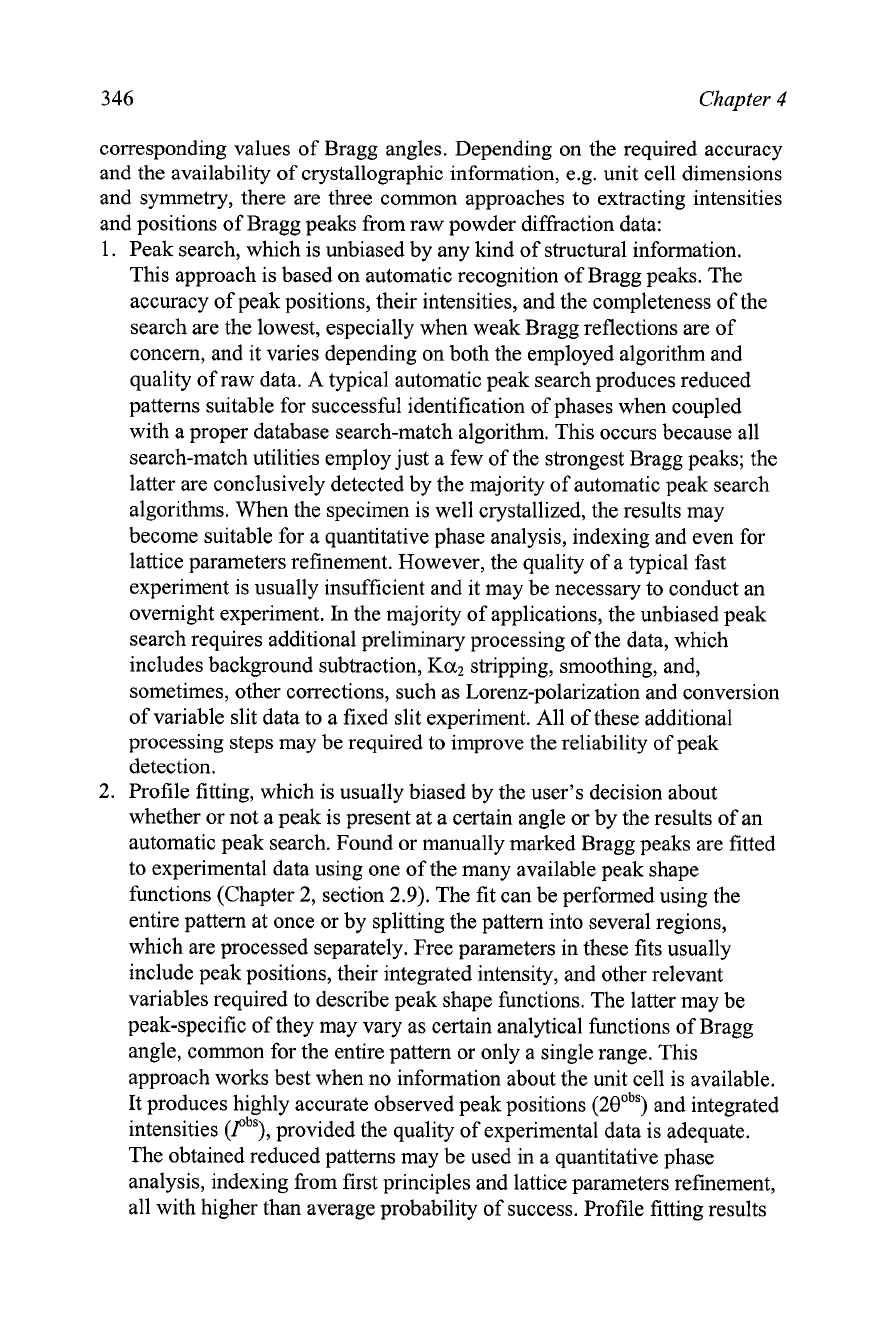
346
Chapter
4
corresponding values of Bragg angles. Depending on the required accuracy
and the availability of crystallographic information, e.g. unit cell dimensions
and symmetry, there are three common approaches to extracting intensities
and positions of Bragg peaks from raw powder diffraction data:
1.
Peak search, which is unbiased by any kind of structural information.
This approach is based on automatic recognition of Bragg peaks. The
accuracy of peak positions, their intensities, and the completeness of the
search are the lowest, especially when weak Bragg reflections are of
concern, and it varies depending on both the employed algorithm and
quality of raw data. A typical automatic peak search produces reduced
patterns suitable for successful identification of phases when coupled
with a proper database search-match algorithm. This occurs because all
search-match utilities employ just a few of the strongest Bragg peaks; the
latter are conclusively detected by the majority of automatic peak search
algorithms. When the specimen is well crystallized, the results may
become suitable for a quantitative phase analysis, indexing and even for
lattice parameters refinement. However, the quality of a typical fast
experiment is usually insufficient and it may be necessary to conduct an
overnight experiment.
In
the majority of applications, the unbiased peak
search requires additional preliminary processing of the data, which
includes background subtraction,
Ka2
stripping, smoothing, and,
sometimes, other corrections, such as Lorenz-polarization and conversion
of variable slit data to a fixed slit experiment. All of these additional
processing steps may be required to improve the reliability of peak
detection.
2.
Profile fitting, which is usually biased by the user's decision about
whether or not a peak is present at a certain angle or by the results of an
automatic peak search. Found or manually marked Bragg peaks are fitted
to experimental data using one of the many available peak shape
functions (Chapter
2,
section
2.9).
The fit can be performed using the
entire pattern at once or by splitting the pattern into several regions,
which are processed separately. Free parameters in these fits usually
include peak positions, their integrated intensity, and other relevant
variables required to describe peak shape functions. The latter may be
peak-specific of they may vary as certain analytical functions of Bragg
angle, common for the entire pattern or only a single range. This
approach works best when no information about the unit cell is available.
It produces highly accurate observed peak positions
(200bS)
and integrated
intensities
(Pb",
provided the quality of experimental data is adequate.
The obtained reduced patterns may be used in a quantitative phase
analysis, indexing from first principles and lattice parameters refinement,
all with higher than average probability of success. Profile fitting results
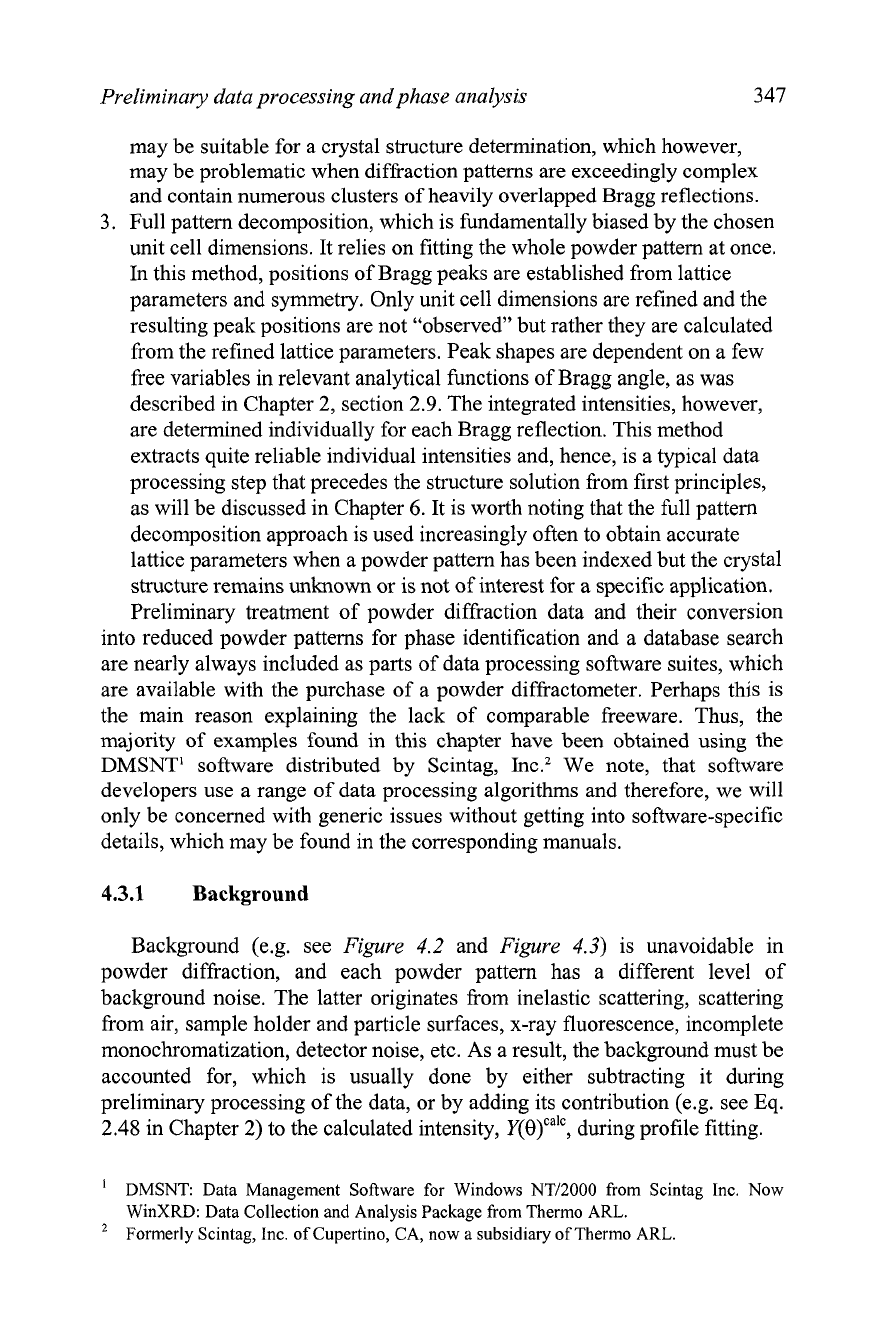
Preliminary data processing and phase analysis
347
may be suitable for a crystal structure determination, which however,
may be problematic when diffraction patterns are exceedingly complex
and contain numerous clusters of heavily overlapped Bragg reflections.
3.
Full pattern decomposition, which is fundamentally biased by the chosen
unit cell dimensions. It relies on fitting the whole powder pattern at once.
In this method, positions of Bragg peaks are established from lattice
parameters and symmetry. Only unit cell dimensions are refined and the
resulting peak positions are not "observed" but rather they are calculated
from the refined lattice parameters. Peak shapes are dependent on a few
free variables in relevant analytical functions of Bragg angle, as was
described in Chapter 2, section
2.9.
The integrated intensities, however,
are determined individually for each Bragg reflection. This method
extracts quite reliable individual intensities and, hence, is a typical data
processing step that precedes the structure solution from first principles,
as will be discussed in Chapter
6.
It is worth noting that the full pattern
decomposition approach is used increasingly often to obtain accurate
lattice parameters when a powder pattern has been indexed but the crystal
structure remains
unhown or is not of interest for a specific application.
Preliminary treatment of powder diffraction data and their conversion
into reduced powder patterns for phase identification and a database search
are nearly always included as parts of data processing software suites, which
are available with the purchase of a powder diffractometer. Perhaps this is
the main reason explaining the lack of comparable freeware. Thus, the
majority of examples found in this chapter have been obtained using the
DMSNT' software distributed by Scintag,
Inc.' We note, that software
developers use a range of data processing algorithms and therefore, we will
only be concerned with generic issues without getting into software-specific
details, which may be found in the corresponding manuals.
4.3.1
Background
Background (e.g. see
Figure
4.2 and
Figure
4.3) is unavoidable in
powder diffiaction, and each powder pattern has a different level of
background noise. The latter originates from inelastic scattering, scattering
from air, sample holder and particle surfaces, x-ray fluorescence, incomplete
monochromatization, detector noise, etc. As a result, the background must be
accounted for, which is usually done by either subtracting it during
preliminary processing of the data, or by adding its contribution
(e.g. see Eq.
2.48
in Chapter 2) to the calculated intensity, Y(B)~~'~, during profile fitting.
'
DMSNT: Data Management Software for Windows NTl2000 from Scintag Inc. Now
WinXRD: Data Collection and Analysis Package from Thermo ARL.
Formerly Scintag, Inc. of Cupertino, CA, now a subsidiary of Thermo ARL.
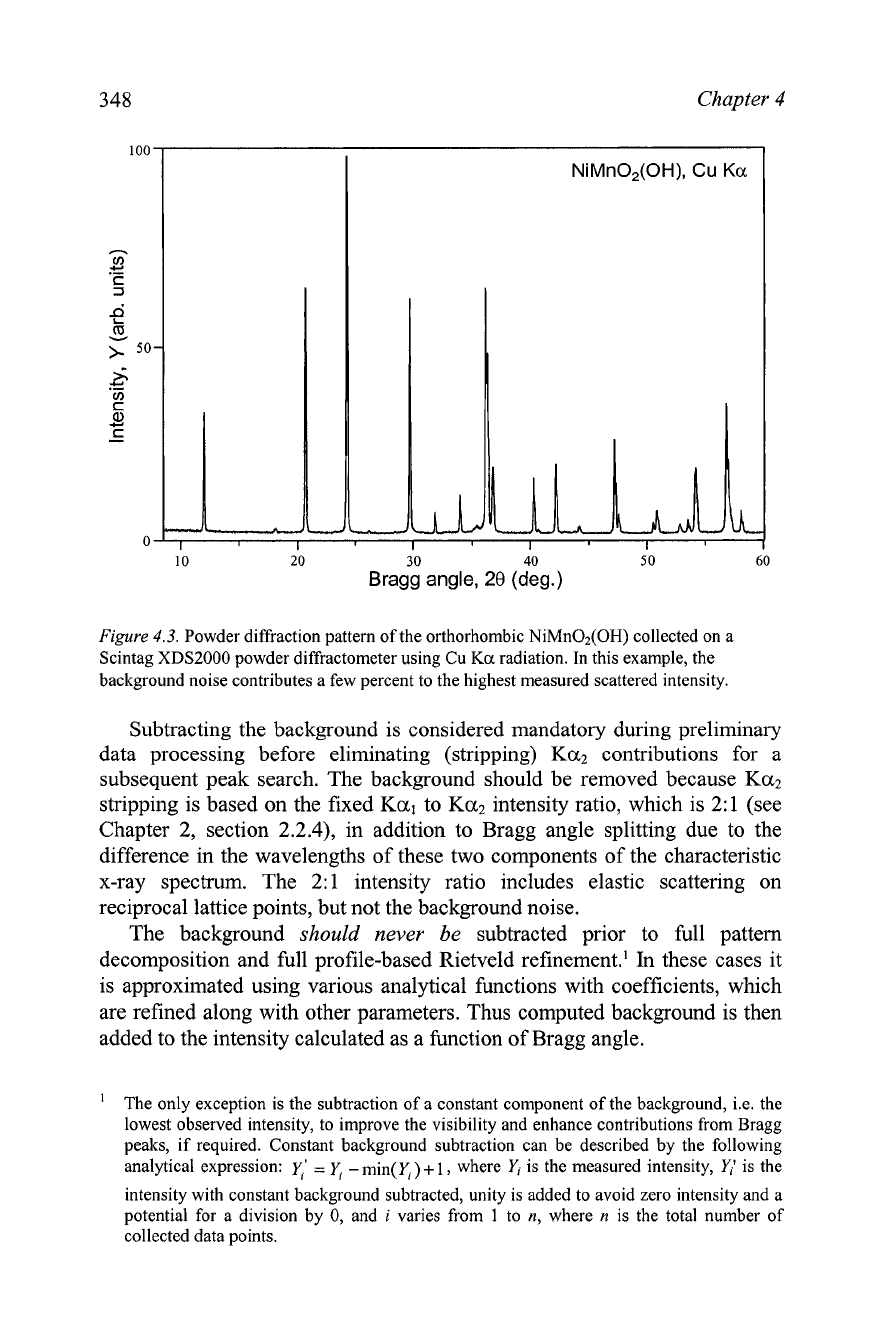
Chapter 4
10
20
30
40
50
Bragg angle,
28
(deg.)
Figure
4.3.
Powder diffraction pattern of the orthorhombic NiMn02(0H) collected on a
Scintag
XDS2000
powder diffractometer using Cu
Ka
radiation. In this example, the
background noise contributes a few percent to the highest measured scattered intensity.
Subtracting the background is considered mandatory during preliminary
data processing before eliminating (stripping)
Ka2
contributions for a
subsequent peak search. The background should be removed because
Ka2
stripping is based on the fixed
Kal
to
Ka2
intensity ratio, which is
2:
1
(see
Chapter
2,
section
2.2.4),
in addition to Bragg angle splitting due to the
difference in the wavelengths of these two components of the characteristic
x-ray spectrum. The
2:l
intensity ratio includes elastic scattering on
reciprocal lattice points, but not the background noise.
The background
should never be
subtracted prior to full pattern
decomposition and full profile-based Rietveld refinement.'
In
these cases it
is approximated using various analytical functions with coefficients, which
are refined along with other parameters. Thus computed background is then
added to the intensity calculated as a function of Bragg angle.
'
The only exception is the subtraction of a constant component of the background, i.e. the
lowest observed intensity, to improve the visibility and enhance contributions from Bragg
peaks, if required. Constant background subtraction can be described by the following
analytical expression:
y,'
=
y,
-
min(Y,)
+
1,
where
Y,
is the measured intensity,
Y/
is the
intensity with constant background subtracted, unity is added to avoid zero intensity and a
potential for a division by
0,
and
i
varies from
1
to
n,
where
n
is the total number of
collected data points.
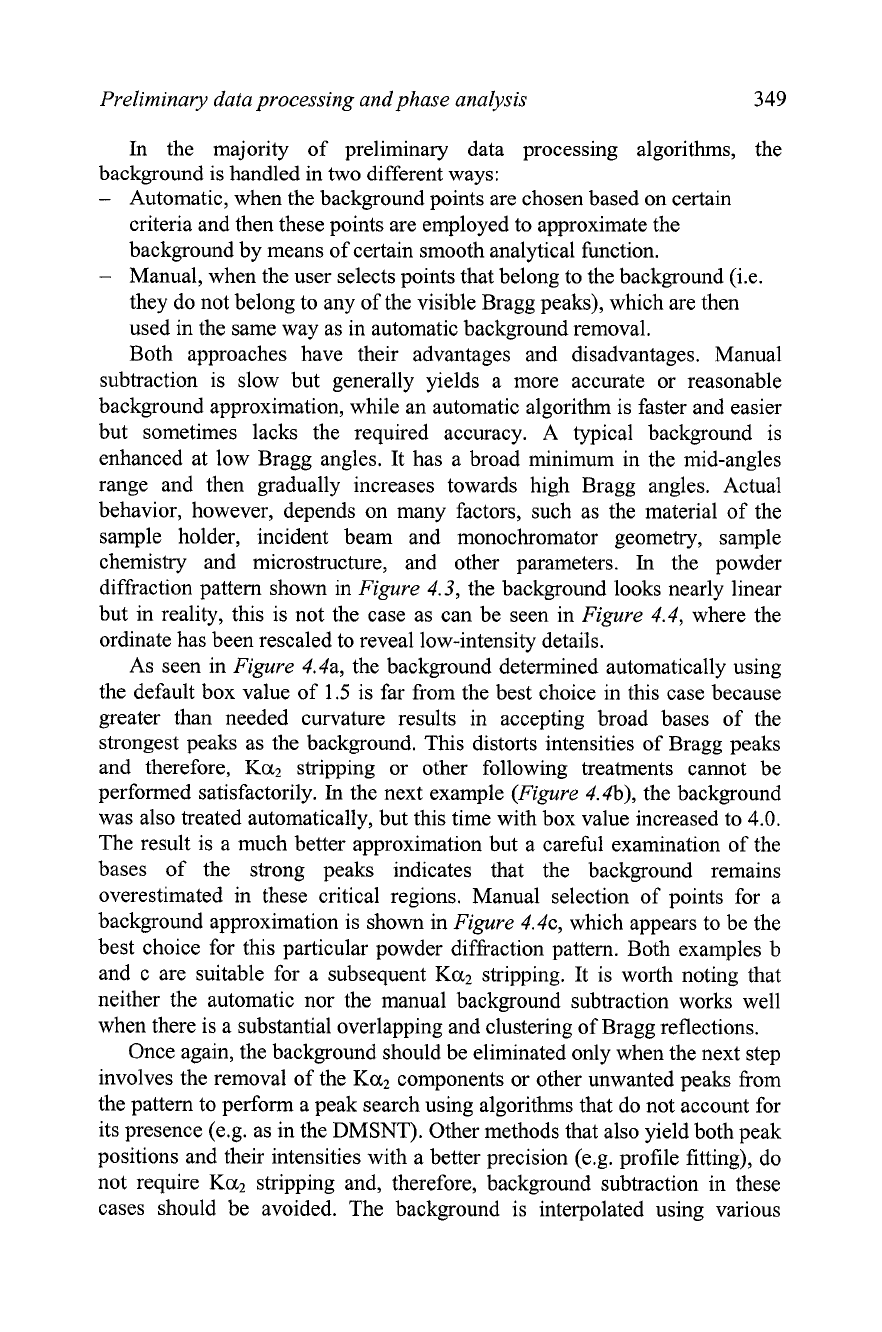
Preliminary data processing and phase analysis
349
In the majority of preliminary data processing algorithms, the
background is handled in two different ways:
-
Automatic, when the background points are chosen based on certain
criteria and then these points are employed to approximate the
background by means of certain smooth analytical function.
-
Manual, when the user selects points that belong to the background (i.e.
they do not belong to any of the visible Bragg peaks), which are then
used in the same way as in automatic background removal.
Both approaches have their advantages and disadvantages. Manual
subtraction is slow but generally yields a more accurate or reasonable
background approximation, while an automatic algorithm is faster and easier
but sometimes lacks the required accuracy. A typical background is
enhanced at low Bragg angles. It has a broad minimum in the mid-angles
range and then gradually increases towards high Bragg angles. Actual
behavior, however, depends on many factors, such as the material of the
sample holder, incident beam and monochromator geometry, sample
chemistry and microstructure, and other parameters.
In
the powder
diffraction pattern shown in
Figure
4.3, the background looks nearly linear
but in reality, this is not the case as can be seen in
Figure
4.4, where the
ordinate has been rescaled to reveal low-intensity details.
As seen in
Figure
4.4a, the background determined automatically using
the default box value of
1.5
is far from the best choice in this case because
greater than needed curvature results in accepting broad bases of the
strongest peaks as the background. This distorts intensities of Bragg peaks
and therefore,
Ka2
stripping or other following treatments cannot be
performed satisfactorily.
In
the next example
(Figure
4.4b), the background
was also treated automatically, but this time with box value increased to
4.0.
The result is a much better approximation but a careful examination of the
bases of the strong peaks indicates that the background remains
overestimated in these critical regions. Manual selection of points for a
background approximation is shown in
Figure
4.4c, which appears to be the
best choice for this particular powder diffraction pattern. Both examples b
and
c
are suitable for a subsequent
Ka2
stripping. It is worth noting that
neither the automatic nor the manual background subtraction works well
when there is a substantial overlapping and clustering of Bragg reflections.
Once again, the background should be eliminated only when the next step
involves the removal of the
Ka2
components or other unwanted peaks from
the pattern to perform a peak search using algorithms that do not account for
its presence (e.g. as in the DMSNT). Other methods that also yield both peak
positions and their intensities with a better precision (e.g. profile fitting), do
not require
Ka2
stripping and, therefore, background subtraction in these
cases should be avoided. The background is interpolated using various
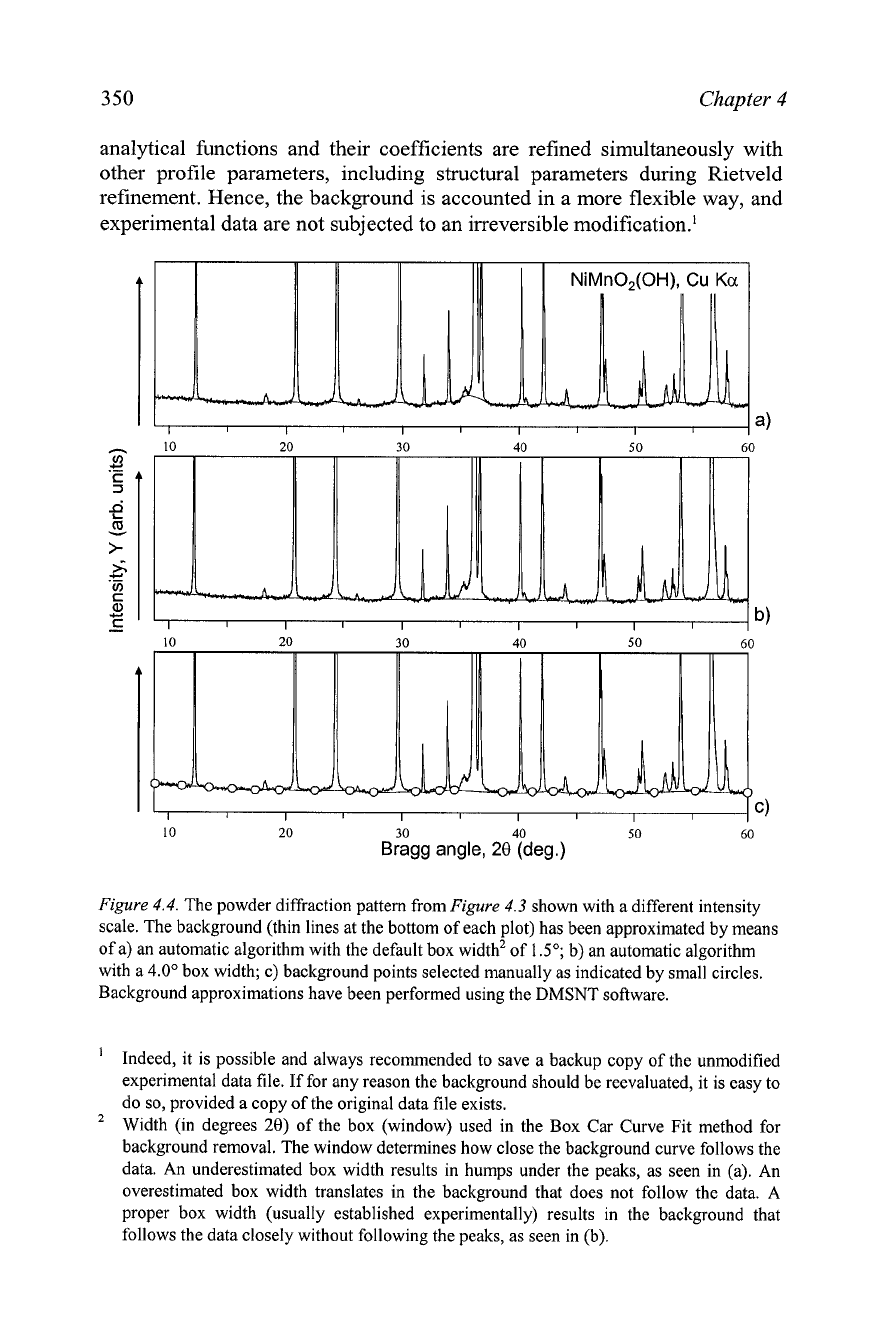
350
Chapter
4
analytical functions and their coefficients are refined simultaneously with
other profile parameters, including structural parameters during Rietveld
refinement. Hence, the background is accounted in a more flexible way,
experimental data are not subjected to an irreversible modification.'
and
a)
10 20
30
40 50
60
Bragg angle,
20
(deg.)
Figure
4.4.
The powder diffraction pattern from
Figure
4.3
shown with a different intensity
scale. The background (thin lines at the bottom of each plot) has been approximated by means
of a) an automatic algorithm with the default box width2 of
1
So;
b) an automatic algorithm
with a
4.0"
box width; c) background points selected manually as indicated by small circles.
Background approximations have been performed using the DMSNT software.
'
Indeed, it is possible and always recommended to save a backup copy of the unmodified
experimental data file. If for any reason the background should be reevaluated, it is easy to
do so, provided a copy of the original data file exists.
Width (in degrees 20) of the box (window) used in the Box Car Curve Fit method for
background removal. The window determines how close the background curve follows the
data. An underestimated box width results in humps under the peaks, as seen in (a). An
overestimated box width translates in the background that does not follow the data. A
proper box width (usually established experimentally) results in the background that
follows the data closely without following the peaks, as seen in (b).
